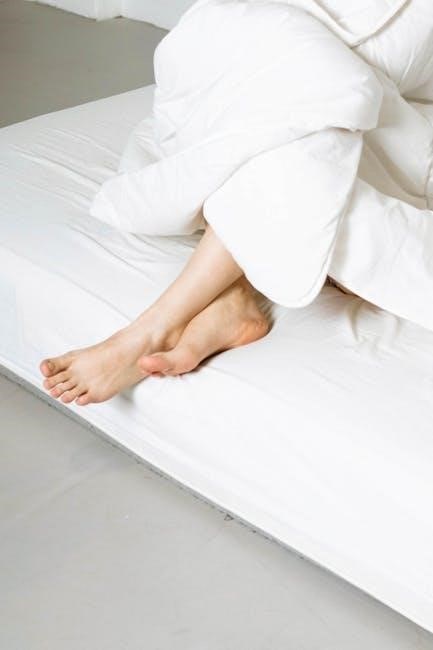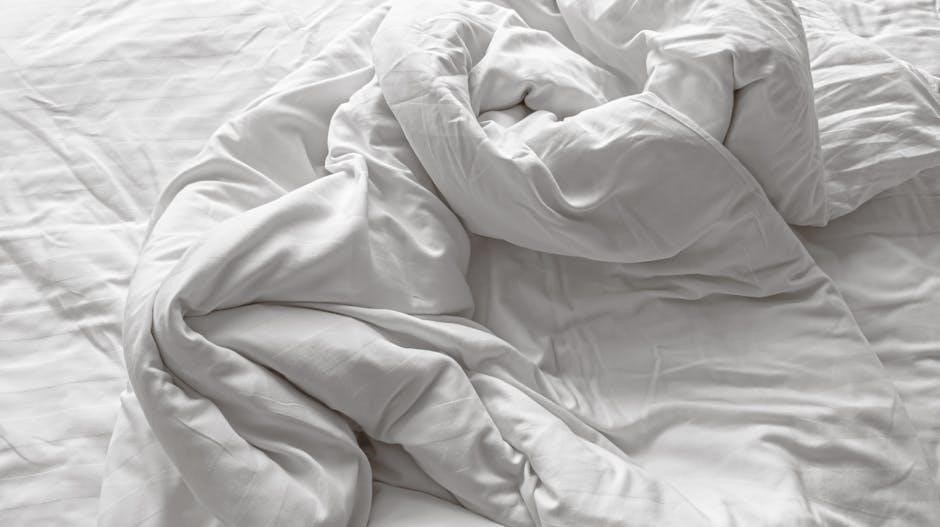Welcome to our guide on washing oat duvet covers! Proper care ensures longevity and softness. Learn how to spot treat stains‚ choose the right detergent‚ and dry effectively for a fresh‚ clean look.
1.1 Importance of Proper Washing for Oat Duvet Covers
Proper washing is essential to maintain the quality and longevity of oat duvet covers. Improper care can lead to shrinkage‚ damage to fibers‚ or loss of softness. Using harsh chemicals or hot water can weaken the fabric‚ while neglecting regular cleaning allows sweat and microorganisms to accumulate. Oat fabric‚ known for its natural breathability and softness‚ requires gentle handling to preserve its texture. Washing too frequently or with the wrong methods can cause wear and tear‚ reducing the duvet cover’s lifespan. Conversely‚ following care instructions ensures a fresh‚ clean‚ and comfortable bedding experience. Regular‚ gentle cleaning also prevents odors and stains from becoming embedded‚ keeping your oat duvet cover looking and feeling its best.
1.2 Brief Overview of Oat Fabric and Its Care Requirements
Oat fabric is a natural‚ breathable material prized for its softness and comfort. It is often used in bedding due to its gentle feel and durability. However‚ oat fabric requires specific care to maintain its quality. Washing in cold or lukewarm water on a gentle cycle is recommended to prevent shrinkage and fiber damage. Avoiding bleach and harsh detergents is crucial‚ as these can weaken the fabric over time. Oat duvet covers should not be ironed directly‚ and line drying is preferred to preserve texture. Proper care ensures the fabric remains soft‚ breathable‚ and long-lasting‚ making it ideal for bedding. Regular maintenance also helps prevent the buildup of odors and stains‚ keeping your oat duvet cover fresh and hygienic.

Checking the Care Label
Checking the care label ensures safe and effective washing. It guides fabric type‚ temperature‚ and detergent use. Ignoring it risks damage or color fading‚ which can ruin the duvet cover.
2.1 Understanding Symbols and Instructions on the Care Label
Understanding the symbols and instructions on the care label is crucial for proper washing. These symbols indicate fabric type‚ recommended washing methods‚ and drying preferences. Common symbols include a tub for washing‚ a circle for dry cleaning‚ and lines or dots for temperature settings. Icons like a hand or machine symbol differentiate between hand and machine washing. Additional symbols may specify gentle cycles‚ bleach usage‚ or ironing instructions. Always check for special care instructions‚ as oat fabric may require specific treatments. Ignoring these guidelines can lead to damage‚ shrinkage‚ or color fading. Consulting the label ensures the duvet cover remains soft‚ durable‚ and maintains its quality over time.

2.2 Common Care Label Instructions for Oat Duvet Covers
Common care label instructions for oat duvet covers often include washing in cold water (below 30°C) to preserve softness and color. Gentle cycles or hand washing are typically recommended to avoid fabric damage. Bleach and harsh detergents should be avoided‚ as they can weaken oat fibers. Tumble drying on low heat or line drying is usually advised‚ while high heat may shrink or damage the fabric. Ironing on a low setting is acceptable‚ but direct contact with the oat fabric should be avoided. Some labels may specify dry cleaning‚ but this is less common. Always adhere to these guidelines to maintain the duvet cover’s texture‚ breathability‚ and longevity.

Pre-Washing Preparation
Pre-washing preparation involves inspecting for stains‚ turning the duvet cover inside out‚ and sorting laundry to prevent color bleeding and fabric damage during washing.
3.1 Spot Treating Stains Before Washing
Spot treating stains before washing is essential to prevent them from setting in. For food or ink stains‚ gently blot the area with a clean cloth to remove excess residue. Avoid rubbing‚ as it may damage the oat fabric. Apply a small amount of mild detergent or a mixture of equal parts water and white vinegar directly to the stain. Let it sit for 10–15 minutes to allow the solution to penetrate. For oil-based stains‚ sprinkle baking soda or use an enzyme-based cleaner to break down the oil. Rinse with cold water before washing. Always test a small‚ inconspicuous area first to ensure the treatment doesn’t discolor the fabric. This step ensures effective stain removal while maintaining the duvet cover’s quality.
3.2 Pre-Treating Oil-Based Stains with Natural Remedies
For oil-based stains on oat duvet covers‚ natural remedies can effectively remove the stain without damaging the fabric. Start by blotting the stain with a clean cloth to absorb excess oil. Next‚ sprinkle baking soda liberally over the affected area and let it sit for 30 minutes to an hour. This helps absorb the oil and neutralize the stain. Alternatively‚ mix equal parts white vinegar and water‚ and gently apply the solution to the stain using a soft-bristled brush. Allow it to sit for 10–15 minutes before rinsing with cold water. For tougher stains‚ a small amount of lemon juice can be applied directly. Always test a small‚ inconspicuous area first to ensure the remedy doesn’t discolor the fabric. These natural methods are gentle and effective for maintaining the quality of oat fabric.
3.3 Sorting Laundry to Prevent Color Bleeding
Sorting laundry is essential to prevent color bleeding and ensure your oat duvet cover retains its vibrant hues. Separate brightly colored or new duvet covers from whites and light-colored fabrics. Newer items‚ especially those with intense dyes‚ are more prone to bleeding. Consider washing similar colors together to minimize the risk of dye transfer. Additionally‚ sort items by fabric type to avoid abrasion—delicates like oat fabric should not be washed with rougher materials. Use mesh laundry bags for extra protection; Always check the care label for specific sorting recommendations‚ as some oat duvet covers may require separate washing altogether. Proper sorting ensures a safer and more effective washing process.
Choosing the Right Detergent
Selecting the right detergent is crucial for maintaining the quality of your oat duvet cover. Opt for a gentle‚ eco-friendly detergent that is suitable for delicate fabrics and prevents damage or discoloration.
4.1 Selecting a Gentle or Eco-Friendly Detergent
Choosing a gentle or eco-friendly detergent is essential for washing oat duvet covers. These detergents are specifically designed to be less harsh on fabrics‚ preserving the softness and texture of oat material. Opt for a phosphate-free‚ biodegradable option to minimize environmental impact while ensuring effective cleaning. Avoid detergents with bleach or optical brighteners‚ as they can weaken the fabric over time. Instead‚ look for plant-based or fragrance-free detergents that are suitable for delicate or sensitive fabrics. Always check the detergent label for certifications like OEKO-TEX or EcoCert‚ which guarantee safety for both the fabric and the environment. Using the right detergent helps maintain the duvet cover’s quality and prevents damage during washing.
4.2 Avoiding Harsh Chemicals and Bleach
Avoiding harsh chemicals and bleach is crucial when washing oat duvet covers‚ as these can damage the fabric and weaken its fibers. Bleach‚ in particular‚ can cause discoloration and break down the natural softness of oat material. Harsh detergents containing strong alkalis or abrasives can also lead to fraying or holes over time. Instead of using bleach‚ opt for natural stain removers like white vinegar or baking soda to gently tackle tough spots. Always choose a detergent free from harsh additives to preserve the fabric’s integrity. Additionally‚ avoid fabric softeners‚ as they can leave a residue that affects the breathability of the oat fabric. By steering clear of these harsh chemicals‚ you ensure your duvet cover remains soft‚ durable‚ and maintains its natural texture.

Washing Methods
Oat duvet covers can be washed using various methods‚ including machine washing on a gentle cycle or hand washing for delicate fabrics. Always avoid over-washing.
5.1 Machine Washing on a Gentle Cycle
Machine washing oat duvet covers on a gentle cycle is a convenient and effective method. Use cold water to prevent shrinkage and maintain fabric softness. Choose a mild detergent that is free from harsh chemicals or bleach. Place the duvet cover in a mesh laundry bag for added protection during the wash cycle. Avoid overloading the washing machine to ensure gentle agitation. Once the cycle is complete‚ remove the cover promptly to prevent wrinkles. Gently reshape the fabric while it’s damp to maintain its original dimensions. For best results‚ air-dry or tumble dry on a low heat setting. This method ensures the oat fabric remains soft and durable.
5.2 Hand Washing for Delicate Oat Duvet Covers
Hand washing is ideal for delicate oat duvet covers that require extra care. Fill a large basin with cold water and add a small amount of mild‚ eco-friendly detergent. Submerge the duvet cover and gently agitate the water with your hands to distribute the soap evenly. Avoid scrubbing or wringing‚ as this can damage the fabric. Let it soak for about 15 minutes before rinsing thoroughly with cold water until no soap remains. Gently squeeze out excess water without twisting. Lay the cover flat on a clean towel‚ roll it up‚ and press to remove moisture. Allow it to air-dry away from direct sunlight. This method preserves the fabric’s softness and texture‚ ensuring longevity.
5.3 When to Avoid Washing the Duvet Cover

There are instances when washing an oat duvet cover should be avoided to maintain its quality. Over-washing can degrade the fabric‚ causing it to lose its softness and texture. If the cover is not visibly soiled or odor-free‚ washing may be unnecessary. Spot cleaning minor stains is often sufficient. Additionally‚ if the care label recommends dry cleaning or specifies that washing should only occur when heavily soiled‚ it’s best to follow those guidelines. Excessive washing can lead to shrinkage or color fading‚ especially if high heat or harsh detergents are used. Preserve the duvet cover’s longevity by washing it only when absolutely necessary.
Drying Methods
Oat duvet covers can be dried using various methods to preserve their softness and texture. Air drying is recommended for maintaining fabric quality and preventing shrinkage.
6.1 Line Drying to Maintain Fabric Quality
Line drying is the best method to maintain the quality of your oat duvet cover. Air drying prevents shrinkage and preserves the fabric’s softness. Hang the cover on a sturdy clothesline or hanger‚ ensuring good airflow. Avoid direct sunlight‚ as it may cause fading; Gently shake the cover before hanging to remove excess moisture. For even drying‚ avoid bunching or folding the fabric. If using a hanger‚ choose one with a wide shoulder to prevent stretching. Line drying may take longer‚ but it’s gentler on the fabric compared to machine drying. Once dry‚ remove immediately to prevent wrinkles. This method ensures your oat duvet cover remains in excellent condition for years.
6.2 Tumble Drying on a Low Heat Setting
Tumble drying your oat duvet cover on a low heat setting is a viable alternative to line drying. This method preserves the fabric’s softness and prevents shrinkage. Ensure the duvet cover isn’t excessively wet before placing it in the dryer. Use a low heat cycle and remove the cover immediately after drying to prevent wrinkles. Always refer to the care label for specific instructions. Avoid overloading the dryer and ensure it’s clean to prevent lint buildup. High heat should be avoided to protect the oat fabric. If wrinkles remain‚ iron on a low setting while the fabric is damp‚ avoiding direct contact with the oat material. Regularly cleaning the dryer’s lint filter improves efficiency and safety. This method ensures your duvet cover remains in great condition.
6.3 Avoiding High Heat to Prevent Shrinkage
Avoiding high heat is crucial when drying an oat duvet cover to prevent shrinkage and damage to the fabric. Oat fabric is sensitive to extreme temperatures‚ and high heat can cause it to shrink or lose its softness. If using a tumble dryer‚ always opt for a low heat setting. When line drying‚ ensure the duvet cover is not exposed to direct sunlight for extended periods‚ as this can also cause shrinkage. Ironing should be done on a low heat setting‚ and avoid ironing directly on the oat fabric. By keeping temperatures low‚ you preserve the natural texture and ensure the duvet cover remains comfortable and durable. This careful approach maintains the quality of your oat duvet cover for years to come.

Ironing and Smoothing
Ironing oat duvet covers requires care to maintain their softness and texture. Iron when slightly damp‚ using a low heat setting‚ and avoid direct contact with the fabric.
7.1 Ironing on a Low Heat Setting
Ironing an oat duvet cover requires careful attention to maintain its soft texture and prevent damage. Always use a low heat setting‚ as high heat can shrink or discolor the fabric. Ensure the duvet cover is slightly damp before ironing‚ as this helps remove wrinkles more effectively. Place a clean‚ lightweight cloth or cotton sheet between the iron and the duvet cover to protect the fabric from direct heat. Avoid applying too much pressure‚ as oat fabric can be delicate. Iron in smooth‚ even strokes‚ starting from the top and working your way down. For stubborn wrinkles‚ use steam if your iron allows it‚ but keep the steam setting low to avoid excessive moisture buildup.
7.2 Avoiding Ironing Directly on Oat Fabric
Avoid ironing directly on oat fabric to prevent scorching or weakening the material. Oat fabric is delicate and can easily be damaged by high temperatures or direct heat. Always place a clean‚ thin cloth or cotton sheet between the iron and the duvet cover to act as a barrier. This protects the fabric from direct contact with the iron and reduces the risk of damage. If wrinkles are particularly stubborn‚ consider using steam on a low setting or allowing the duvet cover to air out after washing. Ironing while the fabric is slightly damp can also help smooth out wrinkles without applying too much heat. Always test a small‚ inconspicuous area first to ensure your method won’t harm the fabric.

Maintenance and Care Tips
Regular maintenance ensures the longevity of your oat duvet cover. Clean it periodically‚ store it properly‚ and avoid exposure to direct sunlight for extended periods.
8.1 Regular Cleaning to Prevent Odors and Stains
Regular cleaning is essential to maintain the freshness and hygiene of your oat duvet cover. Aim to clean it every 1-2 weeks‚ depending on usage. Spot clean small stains immediately to prevent them from setting. For deeper cleaning‚ use a mild detergent and lukewarm water‚ either by hand washing or using a gentle machine cycle. Avoid using harsh chemicals or bleach‚ as they can damage the fabric. Air drying is recommended to preserve the fabric’s natural texture. For odor prevention‚ consider adding a fabric refresher or simply airing out the duvet cover in a well-ventilated area. Regular maintenance ensures your oat duvet cover remains soft‚ clean‚ and free from unpleasant smells.
8.2 Storing the Duvet Cover Properly
To maintain the quality of your oat duvet cover‚ proper storage is essential. Store it in a cool‚ dry place away from direct sunlight to prevent fading or damage. Use a breathable storage bag‚ such as one made of cotton or linen‚ to allow airflow and prevent moisture buildup. Avoid plastic bags‚ as they can trap humidity and lead to mildew. Fold the duvet cover neatly or roll it to save space and reduce creases. Ensure the cover is completely dry before storing to avoid odors or mold. For long-term storage‚ consider adding a natural fabric refresher or dried herbs like lavender to keep it smelling fresh. Proper storage preserves the fabric’s integrity and ensures it remains soft and clean for future use.

Common Mistakes to Avoid
Common mistakes include using hot water‚ harsh detergents‚ over-drying‚ and improper storage‚ which can shrink‚ fade‚ or damage the fabric.
9.1 Washing Too Frequently

Washing your oat duvet cover too frequently can lead to premature wear and tear. Oat fabric is delicate‚ and excessive washing can cause it to lose its softness and develop small tears. It’s essential to balance cleanliness with fabric preservation. Instead of washing after every use‚ consider spot cleaning for minor stains. For full washes‚ a gentle cycle with a mild detergent is recommended. Aim to wash your oat duvet cover every three to four months‚ or as needed based on usage. Proper drying is also crucial to prevent moisture buildup‚ which can lead to odors or mold. By maintaining this routine‚ you can ensure your oat duvet cover remains soft‚ durable‚ and fresh for a longer period.
9.2 Using Hot Water and Harsh Detergents
Using hot water and harsh detergents on oat duvet covers can significantly damage the fabric. Hot water can cause oat fibers to shrink or become brittle‚ leading to a rough texture and reduced softness. Harsh detergents‚ especially those containing bleach or strong chemicals‚ can strip the fabric of its natural oils‚ causing it to lose its softness and potentially leading to discoloration. To preserve the quality of your oat duvet cover‚ always use cold or lukewarm water and a mild‚ eco-friendly detergent. Avoiding these common mistakes ensures the fabric remains soft‚ breathable‚ and durable for a longer period. Proper care will help maintain the natural beauty and comfort of your oat duvet cover.
Proper washing and care routines are essential for maintaining the quality of oat duvet covers. Always use cold water‚ gentle detergents‚ and avoid harsh chemicals to preserve softness and durability. Regular maintenance and thoughtful storage will keep your duvet cover fresh and comfortable for years. By following these guidelines‚ you ensure your oat duvet remains a cozy and stylish addition to your bedding.
10.1 Summary of Best Practices for Washing Oat Duvet Covers
Washing oat duvet covers requires attention to detail to preserve their softness and durability. Always check the care label and opt for cold water to prevent shrinkage and color fading. Use a gentle or eco-friendly detergent‚ avoiding bleach or harsh chemicals that can damage the fabric. For machine washing‚ select a delicate cycle‚ while hand washing is ideal for extra care. Line drying is recommended to maintain fabric quality‚ but tumble drying on low heat is acceptable if necessary. Avoid high heat to prevent shrinkage; Ironing should be done on a low heat setting‚ preferably on the reverse side; Regular maintenance and proper storage will keep your oat duvet cover fresh and extend its lifespan.
10.2 Final Tips for Maintaining the Quality of Your Oat Duvet Cover
To ensure your oat duvet cover remains soft and vibrant‚ avoid washing it too frequently‚ as over-washing can degrade the fabric. Always store it in a cool‚ dry place‚ away from direct sunlight to prevent fading. Consider using a fabric refresher or mild fabric spray to maintain freshness between washes. For optimal texture‚ avoid ironing unless necessary‚ and never iron directly on the oat fabric. Regularly fluffing the duvet cover can help maintain its shape and prevent creases. By following these simple care routines‚ you can enjoy your oat duvet cover for years‚ keeping it comfortable and looking its best.
Additional Resources
Explore recommended eco-friendly detergents and fabric protectants for oat duvet covers. Visit manufacturer websites or care guide blogs for detailed washing and maintenance tips tailored to oat fabrics.
11.1 Recommended Products for Washing Oat Duvet Covers
For optimal care‚ use eco-friendly detergents specifically designed for delicate or natural fibers. Look for products labeled as “gentle” or “plant-based‚” as they are less likely to damage oat fabric. Fabric protectants or softeners can enhance the texture without harming the material. Avoid harsh chemicals like bleach‚ as they can degrade the fabric. Consider natural remedies like white vinegar for softening or odor control; Always check the ingredient list to ensure compatibility with oat fibers. Some popular brands offer detergents tailored for sustainable fabrics‚ making them ideal for oat duvet covers. These products are widely available online or in eco-friendly stores.
11.2 Where to Find More Detailed Care Instructions
For more detailed care instructions‚ refer to the manufacturer’s website or the product packaging. Many brands provide specific guidelines tailored to their oat duvet covers. Additionally‚ check the care label on the duvet cover itself‚ as it often includes symbols or written instructions. Online resources like laundry care websites or home decor blogs can offer step-by-step guides. Some fabric care experts share detailed tutorials on platforms like YouTube. Eco-friendly laundry websites often focus on natural fibers‚ offering tips for oat fabric care. Lastly‚ customer service teams for bedding brands can provide personalized advice. These resources ensure you have comprehensive guidance for maintaining your oat duvet cover.
